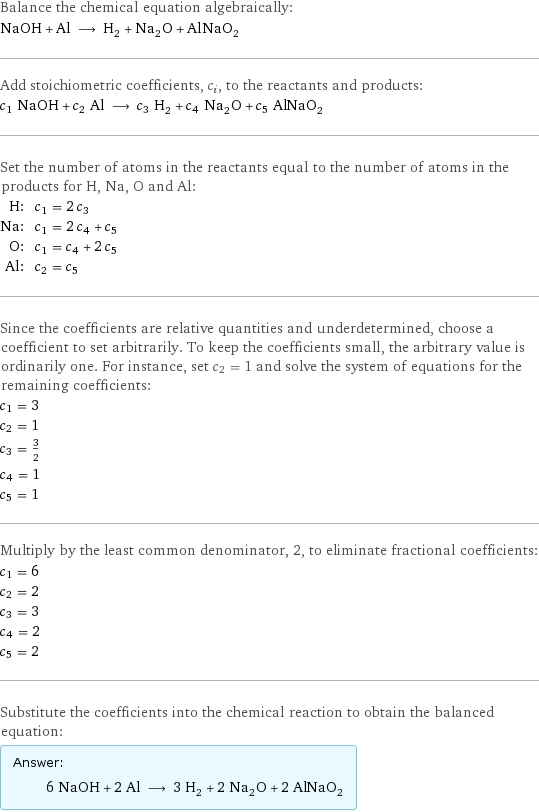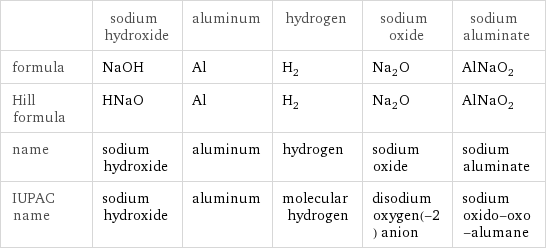Input interpretation

NaOH sodium hydroxide + Al aluminum ⟶ H_2 hydrogen + Na_2O sodium oxide + AlNaO_2 sodium aluminate
Balanced equation

Balance the chemical equation algebraically: NaOH + Al ⟶ H_2 + Na_2O + AlNaO_2 Add stoichiometric coefficients, c_i, to the reactants and products: c_1 NaOH + c_2 Al ⟶ c_3 H_2 + c_4 Na_2O + c_5 AlNaO_2 Set the number of atoms in the reactants equal to the number of atoms in the products for H, Na, O and Al: H: | c_1 = 2 c_3 Na: | c_1 = 2 c_4 + c_5 O: | c_1 = c_4 + 2 c_5 Al: | c_2 = c_5 Since the coefficients are relative quantities and underdetermined, choose a coefficient to set arbitrarily. To keep the coefficients small, the arbitrary value is ordinarily one. For instance, set c_2 = 1 and solve the system of equations for the remaining coefficients: c_1 = 3 c_2 = 1 c_3 = 3/2 c_4 = 1 c_5 = 1 Multiply by the least common denominator, 2, to eliminate fractional coefficients: c_1 = 6 c_2 = 2 c_3 = 3 c_4 = 2 c_5 = 2 Substitute the coefficients into the chemical reaction to obtain the balanced equation: Answer: | | 6 NaOH + 2 Al ⟶ 3 H_2 + 2 Na_2O + 2 AlNaO_2
Structures

+ ⟶ + +
Names

sodium hydroxide + aluminum ⟶ hydrogen + sodium oxide + sodium aluminate
Equilibrium constant
![Construct the equilibrium constant, K, expression for: NaOH + Al ⟶ H_2 + Na_2O + AlNaO_2 Plan: • Balance the chemical equation. • Determine the stoichiometric numbers. • Assemble the activity expression for each chemical species. • Use the activity expressions to build the equilibrium constant expression. Write the balanced chemical equation: 6 NaOH + 2 Al ⟶ 3 H_2 + 2 Na_2O + 2 AlNaO_2 Assign stoichiometric numbers, ν_i, using the stoichiometric coefficients, c_i, from the balanced chemical equation in the following manner: ν_i = -c_i for reactants and ν_i = c_i for products: chemical species | c_i | ν_i NaOH | 6 | -6 Al | 2 | -2 H_2 | 3 | 3 Na_2O | 2 | 2 AlNaO_2 | 2 | 2 Assemble the activity expressions accounting for the state of matter and ν_i: chemical species | c_i | ν_i | activity expression NaOH | 6 | -6 | ([NaOH])^(-6) Al | 2 | -2 | ([Al])^(-2) H_2 | 3 | 3 | ([H2])^3 Na_2O | 2 | 2 | ([Na2O])^2 AlNaO_2 | 2 | 2 | ([AlNaO2])^2 The equilibrium constant symbol in the concentration basis is: K_c Mulitply the activity expressions to arrive at the K_c expression: Answer: | | K_c = ([NaOH])^(-6) ([Al])^(-2) ([H2])^3 ([Na2O])^2 ([AlNaO2])^2 = (([H2])^3 ([Na2O])^2 ([AlNaO2])^2)/(([NaOH])^6 ([Al])^2)](../image_source/b445d07e910342cfcfd6bb3db785906c.png)
Construct the equilibrium constant, K, expression for: NaOH + Al ⟶ H_2 + Na_2O + AlNaO_2 Plan: • Balance the chemical equation. • Determine the stoichiometric numbers. • Assemble the activity expression for each chemical species. • Use the activity expressions to build the equilibrium constant expression. Write the balanced chemical equation: 6 NaOH + 2 Al ⟶ 3 H_2 + 2 Na_2O + 2 AlNaO_2 Assign stoichiometric numbers, ν_i, using the stoichiometric coefficients, c_i, from the balanced chemical equation in the following manner: ν_i = -c_i for reactants and ν_i = c_i for products: chemical species | c_i | ν_i NaOH | 6 | -6 Al | 2 | -2 H_2 | 3 | 3 Na_2O | 2 | 2 AlNaO_2 | 2 | 2 Assemble the activity expressions accounting for the state of matter and ν_i: chemical species | c_i | ν_i | activity expression NaOH | 6 | -6 | ([NaOH])^(-6) Al | 2 | -2 | ([Al])^(-2) H_2 | 3 | 3 | ([H2])^3 Na_2O | 2 | 2 | ([Na2O])^2 AlNaO_2 | 2 | 2 | ([AlNaO2])^2 The equilibrium constant symbol in the concentration basis is: K_c Mulitply the activity expressions to arrive at the K_c expression: Answer: | | K_c = ([NaOH])^(-6) ([Al])^(-2) ([H2])^3 ([Na2O])^2 ([AlNaO2])^2 = (([H2])^3 ([Na2O])^2 ([AlNaO2])^2)/(([NaOH])^6 ([Al])^2)
Rate of reaction
![Construct the rate of reaction expression for: NaOH + Al ⟶ H_2 + Na_2O + AlNaO_2 Plan: • Balance the chemical equation. • Determine the stoichiometric numbers. • Assemble the rate term for each chemical species. • Write the rate of reaction expression. Write the balanced chemical equation: 6 NaOH + 2 Al ⟶ 3 H_2 + 2 Na_2O + 2 AlNaO_2 Assign stoichiometric numbers, ν_i, using the stoichiometric coefficients, c_i, from the balanced chemical equation in the following manner: ν_i = -c_i for reactants and ν_i = c_i for products: chemical species | c_i | ν_i NaOH | 6 | -6 Al | 2 | -2 H_2 | 3 | 3 Na_2O | 2 | 2 AlNaO_2 | 2 | 2 The rate term for each chemical species, B_i, is 1/ν_i(Δ[B_i])/(Δt) where [B_i] is the amount concentration and t is time: chemical species | c_i | ν_i | rate term NaOH | 6 | -6 | -1/6 (Δ[NaOH])/(Δt) Al | 2 | -2 | -1/2 (Δ[Al])/(Δt) H_2 | 3 | 3 | 1/3 (Δ[H2])/(Δt) Na_2O | 2 | 2 | 1/2 (Δ[Na2O])/(Δt) AlNaO_2 | 2 | 2 | 1/2 (Δ[AlNaO2])/(Δt) (for infinitesimal rate of change, replace Δ with d) Set the rate terms equal to each other to arrive at the rate expression: Answer: | | rate = -1/6 (Δ[NaOH])/(Δt) = -1/2 (Δ[Al])/(Δt) = 1/3 (Δ[H2])/(Δt) = 1/2 (Δ[Na2O])/(Δt) = 1/2 (Δ[AlNaO2])/(Δt) (assuming constant volume and no accumulation of intermediates or side products)](../image_source/3f8e5503ad30e700dd678472c1562009.png)
Construct the rate of reaction expression for: NaOH + Al ⟶ H_2 + Na_2O + AlNaO_2 Plan: • Balance the chemical equation. • Determine the stoichiometric numbers. • Assemble the rate term for each chemical species. • Write the rate of reaction expression. Write the balanced chemical equation: 6 NaOH + 2 Al ⟶ 3 H_2 + 2 Na_2O + 2 AlNaO_2 Assign stoichiometric numbers, ν_i, using the stoichiometric coefficients, c_i, from the balanced chemical equation in the following manner: ν_i = -c_i for reactants and ν_i = c_i for products: chemical species | c_i | ν_i NaOH | 6 | -6 Al | 2 | -2 H_2 | 3 | 3 Na_2O | 2 | 2 AlNaO_2 | 2 | 2 The rate term for each chemical species, B_i, is 1/ν_i(Δ[B_i])/(Δt) where [B_i] is the amount concentration and t is time: chemical species | c_i | ν_i | rate term NaOH | 6 | -6 | -1/6 (Δ[NaOH])/(Δt) Al | 2 | -2 | -1/2 (Δ[Al])/(Δt) H_2 | 3 | 3 | 1/3 (Δ[H2])/(Δt) Na_2O | 2 | 2 | 1/2 (Δ[Na2O])/(Δt) AlNaO_2 | 2 | 2 | 1/2 (Δ[AlNaO2])/(Δt) (for infinitesimal rate of change, replace Δ with d) Set the rate terms equal to each other to arrive at the rate expression: Answer: | | rate = -1/6 (Δ[NaOH])/(Δt) = -1/2 (Δ[Al])/(Δt) = 1/3 (Δ[H2])/(Δt) = 1/2 (Δ[Na2O])/(Δt) = 1/2 (Δ[AlNaO2])/(Δt) (assuming constant volume and no accumulation of intermediates or side products)
Chemical names and formulas

| sodium hydroxide | aluminum | hydrogen | sodium oxide | sodium aluminate formula | NaOH | Al | H_2 | Na_2O | AlNaO_2 Hill formula | HNaO | Al | H_2 | Na_2O | AlNaO_2 name | sodium hydroxide | aluminum | hydrogen | sodium oxide | sodium aluminate IUPAC name | sodium hydroxide | aluminum | molecular hydrogen | disodium oxygen(-2) anion | sodium oxido-oxo-alumane
Substance properties

| sodium hydroxide | aluminum | hydrogen | sodium oxide | sodium aluminate molar mass | 39.997 g/mol | 26.9815385 g/mol | 2.016 g/mol | 61.979 g/mol | 81.969 g/mol phase | solid (at STP) | solid (at STP) | gas (at STP) | | solid (at STP) melting point | 323 °C | 660.4 °C | -259.2 °C | | 1800 °C boiling point | 1390 °C | 2460 °C | -252.8 °C | | density | 2.13 g/cm^3 | 2.7 g/cm^3 | 8.99×10^-5 g/cm^3 (at 0 °C) | 2.27 g/cm^3 | 1.5 g/cm^3 solubility in water | soluble | insoluble | | | soluble surface tension | 0.07435 N/m | 0.817 N/m | | | dynamic viscosity | 0.004 Pa s (at 350 °C) | 1.5×10^-4 Pa s (at 760 °C) | 8.9×10^-6 Pa s (at 25 °C) | | odor | | odorless | odorless | |
Units
